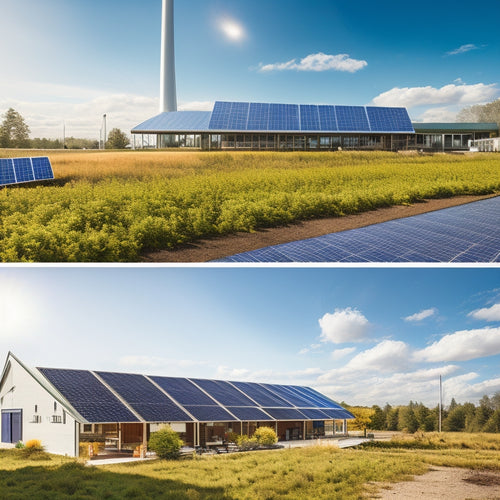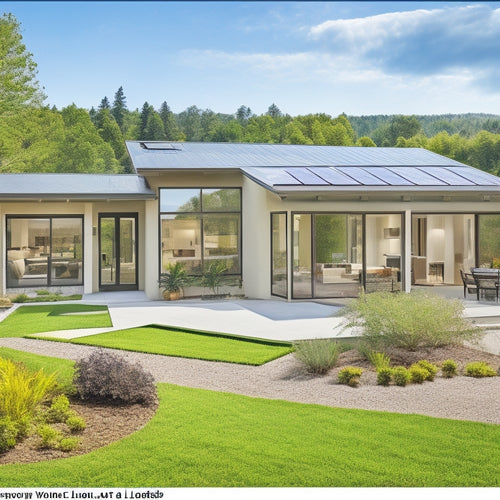
Top Solar Panel Efficiency Ratings Revealed Online
Share
You'll find the top solar panels based on efficiency come from brands like SunPower, LG, and Panasonic. SunPower Maxeon 3 leads with 22.6% efficiency. LG's NeON R follows closely at 22%, while Panasonic's HIT N340 offers 21.6%. Efficiency is measured under Standard Test Conditions (STC) and optimized by Maximum Power Point Tracking (MPPT). Performance is also influenced by temperature coefficients and shading. Opting for panels with ratings above 20% guarantees superior long-term performance. By exploring these options further, you can make an informed decision for your energy needs.
Key Takeaways
- SunPower Maxeon 3 leads with 22.6% efficiency, offering top performance and durability.
- LG NeON R series provides 22% efficiency with a sleek design and sustained performance.
- Panasonic HIT N340 boasts 21.6% efficiency and reduced panel degradation over time.
- REC Alpha Series features 21.7% efficiency and excels in harsh conditions.
- Canadian Solar HiKu series delivers 20.4% efficiency with a solid 25-year warranty.
Leading Solar Panel Brands
https://www.youtube.com/watch?v=GEZO67JJ19I
When evaluating solar panel efficiency, you should consider top brands like SunPower, LG, and Panasonic, which consistently lead the industry with high-performance ratings and innovative technologies.
SunPower, for instance, has a storied brand history dating back to the 1980s, and it has become synonymous with cutting-edge solar innovation. Their Maxeon cell technology has set benchmarks in the market, pushing the boundaries of efficiency and durability.
LG entered the solar market leveraging its extensive electronics experience. Over the years, LG has captured significant market share by focusing on high-efficiency panels that not only perform well but also boast sleek designs. LG's NeON series epitomizes their commitment to innovation, featuring advanced bifacial technology that maximizes energy capture.
Panasonic's journey started with its acquisition of Sanyo's solar division, which had already established a strong reputation. Panasonic builds on this legacy with its HIT (Heterojunction with Intrinsic Thin layer) technology, offering panels that excel in both performance and reliability.
Monitoring market trends, these brands continuously adapt to emerging technologies and consumer demands. By choosing panels from industry leaders like SunPower, LG, and Panasonic, you're investing in proven performance and future-ready technology, ensuring long-term energy liberation.
Highest Efficiency Models
In today's market, the highest efficiency solar panel models are led by SunPower's Maxeon 3, LG's NeON R, and Panasonic's HIT N340, each boasting efficiencies exceeding 21%. These top-tier panels maximize energy output, allowing you to harness more power from the same roof space.
Consider these key attributes:
-
SunPower Maxeon 3: With an efficiency rate of 22.6%, this panel stands out for its robust energy output and low panel degradation rate of 0.25% per year.
-
LG NeON R: This model delivers 22% efficiency and features a unique design that minimizes energy loss, ensuring sustained performance over time.
-
Panasonic HIT N340: Known for its 21.6% efficiency, this panel leverages a heterojunction cell structure to reduce panel degradation significantly, offering a degradation rate of just 0.26% per year.
- REC Alpha Series: Offering 21.7% efficiency, these panels are built to endure harsh conditions, maintaining high energy output with a degradation rate of 0.25% annually.
You're not just investing in solar panels; you're investing in freedom from rising energy costs and environmental impact. These models provide long-term reliability and superior performance, maximizing your return on investment while reducing your carbon footprint.
Comparing Efficiency Ratings
You need to take into account efficiency measurement standards when comparing solar panels, as different testing conditions can yield varying results.
Top-rated solar brands consistently demonstrate high efficiency under standardized tests. However, their performance may fluctuate under real-world conditions, impacting overall energy output.
Efficiency Measurement Standards
Solar panel efficiency ratings are determined through standardized tests that measure the amount of sunlight converted into usable electricity under specific conditions. These tests follow strict standard protocols to guarantee consistency and reliability.
By understanding these measurement techniques, you'll gain a clearer perspective on how different panels perform in real-world scenarios.
To make sense of these ratings, here's what you need to know:
-
Standard Test Conditions (STC): Panels are evaluated at a set solar irradiance of 1000 watts per square meter, a cell temperature of 25°C, and an air mass of 1.5. These uniform conditions allow for accurate efficiency comparisons.
-
Nominal Operating Cell Temperature (NOCT): This measures panel performance under more realistic conditions, typically at an irradiance of 800 watts per square meter, ambient temperature of 20°C, and wind speed of 1 m/s.
-
Maximum Power Point Tracking (MPPT): This method ensures the panel operates at its peak efficiency by continuously adjusting the electrical operating point.
- Performance Ratio (PR): This metric accounts for losses and environmental factors, providing a realistic measure of a panel's effectiveness in converting sunlight to electricity.
Top-Rated Solar Brands
Given the understanding of efficiency measurement standards, let's compare the efficiency ratings of top-rated solar brands to see how they stand out in real-world performance.
SunPower leads with an impressive 22.8% efficiency, thanks to its Maxeon technology, which has evolved over 35 years of innovation. Their panels come with a 25-year warranty, ensuring long-term reliability.
Similarly, LG's NeON R series boasts a 22% efficiency rating, backed by LG's strong brand history in electronics and a 25-year warranty.
Panasonic's HIT panels offer 21.7% efficiency, combining amorphous and monocrystalline technologies for superior performance. With over a century of engineering expertise, Panasonic provides a 25-year warranty, reflecting their confidence in product longevity.
Canadian Solar's HiKu series, with a 20.4% efficiency, is competitively priced and offers a 25-year warranty, making it a popular choice for budget-conscious consumers.
Lastly, LONGi Solar, a rapidly growing brand, presents panels with 20.6% efficiency. Their 12-year product warranty and 25-year performance guarantee highlight their commitment to quality.
Performance Under Conditions
When evaluating solar panel efficiency ratings under various conditions, it's crucial to take into account factors like temperature coefficients, shading tolerance, and low-light performance. These elements greatly impact how well your solar panels will perform throughout the year, and under different environmental stresses.
Here are four critical points to keep in mind:
-
Temperature Coefficients: Solar panels are sensitive to temperature fluctuations. Panels with lower temperature coefficients will maintain higher efficiency during hot weather. This leads to less energy loss and better overall performance.
-
Shading Impact: Shading can significantly reduce the efficiency of solar panels. Some panels are designed with bypass diodes to minimize shading impact. Look for panels that specify good performance under partial shading conditions to ensure consistent energy production.
-
Low-Light Performance: Not all solar panels are equally effective in low-light conditions. Panels with high low-light performance ratings will generate more electricity during cloudy days or early mornings and late evenings.
- Durability: Environmental conditions such as wind, snow, and hail can impact panel efficiency. Durable panels that withstand harsh conditions without significant degradation guarantee long-term efficiency and energy output.
User Reviews and Feedback
Many users report that while high-efficiency solar panels perform exceptionally well in ideal conditions, their effectiveness can vary greatly depending on installation factors and geographic location. Customer satisfaction often hinges on the quality of the installation experience. For instance, users in regions with less sunlight still observe substantial benefits, provided the panels are installed at best angles and are free from shading.
Data from user reviews indicates that meticulous planning during the installation phase greatly impacts overall performance. Users consistently highlight the importance of professional installers who understand the nuances of geographic and structural factors. Reviews also show a correlation between high customer satisfaction and installers who offer detailed site assessments and customized solutions.
Moreover, technical feedback emphasizes that even minor deviations in installation can lead to diminished efficiency. Users have noted that poorly aligned panels or inadequate mounting systems can reduce energy output by up to 15%. Hence, it's essential to take into account not only the panel's efficiency rating but also the expertise of the installation team.
Ultimately, while the efficiency ratings of solar panels are important, real-world performance and user satisfaction are heavily influenced by installation quality and geographic considerations. This insight empowers you to make informed decisions, ensuring you maximize your investment in solar technology.
Best Value Options
To identify the best value options in solar panels, you should consider not only the initial cost but also the energy output per dollar spent, factoring in both the efficiency ratings and the long-term performance data. This holistic approach guarantees you're getting the most bang for your buck while also planning for sustainable energy production.
Here are four key considerations:
-
Initial Installation Costs: Look for panels that offer a balance between upfront expense and efficiency. High-efficiency panels might cost more initially but can save you money in the long run due to higher energy output.
-
Efficiency Ratings: Aim for panels with efficiency ratings above 20%. These panels convert more sunlight into electricity, giving you more energy for the same amount of space.
-
Long-Term Performance: Check for performance degradation rates. Panels with lower degradation rates maintain efficiency longer, reducing replacement costs and ensuring consistent energy production.
- Maintenance Tips: Choose panels that require minimal upkeep. Panels with self-cleaning technology or those designed to resist dirt and debris can greatly lower your maintenance costs over time.
Where to Buy
You can find high-quality solar panels from reputable suppliers such as SunPower, LG, and Tesla, which offer a range of options tailored to different efficiency needs and budget constraints. These brands not only deliver top-tier efficiency but also provide extensive warranties and customer support, ensuring your investment is secure and fruitful.
When it comes to purchasing locations, online retailers like Amazon, Home Depot, and specialized solar marketplaces such as EnergySage offer a wide selection of solar panels. These platforms allow you to compare prices, read customer reviews, and analyze technical specifications easily. Amazon, for instance, provides user ratings and detailed product descriptions, enabling you to make an informed decision. Home Depot offers professional installation services, which can be a game-changer if you're not keen on a DIY approach.
EnergySage stands out by offering a vast database of solar panel options along with comprehensive guides and a solar calculator to estimate your savings. This data-driven approach empowers you to choose the most efficient panels tailored to your specific needs. Leveraging these online retailers not only simplifies the purchasing process but also aligns with your desire for liberation from traditional energy constraints.
Frequently Asked Questions
How Do Solar Panels Work to Generate Electricity?
Solar panels work by harnessing the photovoltaic effect in semiconductor materials. You convert sunlight into electricity as photons hit the semiconductor, freeing electrons. This generates an electrical current, liberating you from traditional energy sources.
What Maintenance Is Required for Optimal Solar Panel Performance?
Sure, let's pretend you're a solar panel whisperer. To maintain peak performance, establish a cleaning schedule every six months. Follow installation tips religiously to avoid shading. Embrace the liberation of peak efficiency and lower bills.
Can Solar Panels Function During Cloudy or Rainy Days?
Yes, solar panels can function during cloudy or rainy days. While weather impact reduces efficiency, energy storage systems capture excess energy on sunny days, ensuring continuous power supply. Embrace the freedom of reliable, sustainable energy.
What Are the Environmental Benefits of Using Solar Panels?
Imagine a city shifting to solar power; it cuts CO2 emissions by 50%. Using solar panels provides sustainable energy, reducing emissions and promoting a cleaner environment. Your choice liberates future generations from fossil fuel dependency.
How Long Do Solar Panels Typically Last Before Needing Replacement?
Solar panels typically last 25-30 years before needing replacement. You'll find that the degradation rate is about 0.5-1% per year. Most panels come with a warranty period of 20-25 years, ensuring performance and reliability.
Related Posts
-

Innovative Sustainable Materials for Energy-Efficient Homes
Innovative sustainable materials enable you to create energy-efficient homes while promoting environmental responsibi...
-

Off-Grid Solar Solutions for Eco-Conscious Businesses
Off-grid solar solutions offer you a path to both sustainability and substantial cost savings. By adopting these syst...
-

Passive Solar Design Strategies for Homes
To effectively implement passive solar design strategies in your home, focus on ideal building orientation and strate...


